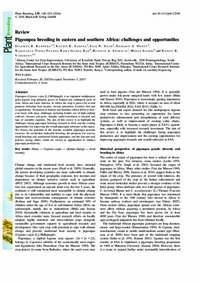Pigeonpea breeding in eastern and southern Africa: challenges and opportunities

Authors:
Pigeonpea (Cajanus cajan [L.] Millspaugh) is an important multipurpose grain legume crop primarily grown in tropical and subtropical areas of Asia, Africa and Latin America. In Africa, the crop is grown for several purposes including food security, income generation, livestock feed and in agroforestry. Production in Eastern and Southern Africa (ESA) is however faced with many challenges including limited use of high-yielding cultivars, diseases and pests, drought, under-investment in research and lack of scientific expertise. The aim of this review is to highlight the challenges facing pigeonpea breeding research in ESA and the existing opportunities for improving the overall pigeonpea subsector in the region. We discuss the potential of the recently available pigeonpea genomic resources for accelerated molecular breeding, the prospects for conventional breeding and commercial hybrid pigeonpea, and the relevant seed policies, among others, which are viewed as opportunities to enhance pigeonpea productivity.
